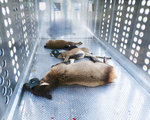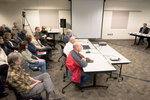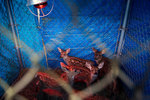



Last Monday, the Washington Department of Fish and Wildlife ordered what amounts to a temporary stay of execution for 11 fawns being cared for in Rochester at For Heaven’s Sake Animals Rescue and Rehabilitation.
But documents obtained by The Chronicle through a public records request indicate that their final chapter was nearly written last month during an action by the WDFW that resulted in the euthanization of three fawns and one elk calf that were deemed by state wildlife staff to be habituated.
A fatal ending was planned for all 15 ungulates at For Heaven’s Sake in a draft press release and other email communications between the WDFW staff before an unforeseen turn of events forced last minute revisions to the official story.
“Wolfhaven is happy to accept any carcasses during the week. Notify their veterinarian (Wendy) ahead of time. Their freezer is in the same building as their main office,” wrote Anthony Novak, a wildlife biologist with the WDFW, in an internal email in the days prior to the Nov. 9 raid on For Heaven’s Sake Animal Rescue and Rehabilitation. “I think the Fall Creek horse campground and trailhead in Capitol forest was one possible site for where to bring the trailer before going to Wolfhaven. Other options are probably available.”
Numerous draft press releases sent out for review by Craig Bartlett from the WDFW public affairs office in advance of the raid by wildlife officials made clear that the planned donation of deer to Wolf Haven International, a sanctuary for wolves, was meant to be a sizable delivery. The beginning of that preemptive press release read in part: “State wildlife managers have euthanized 14 deer fawns and an elk calf that became habituated to humans at a licensed wildlife rehabilitation facility in Thurston County.”
Bartlett’s email solicited suggested edits, and although numerous revisions were generated by WDFW staff, there were no qualms raised over the definitive statement that all 15 ungulates at the facility were set to be seized and euthanized.
While the WDFW planned to remove all of the deer and elk under the care of For Heaven’s Sake in one fell swoop, the reality that has thus far come to pass has been far more convoluted.
First, wildlife officials were unable to capture all of the deer that they had previously deemed too tame for wild release. Claudia Supensky, who owns and operates For Heaven’s Sake with her husband David at their home in Rochester, said that WDFW agents were forced to use an apple to coax the three youngest fawns and elk calf into a position where they could be sedated and ultimately killed. However, Supensky noted that the presence of the WDFW agents thoroughly spooked the remaining 11 deer, which promptly fled into a nearby wooded area. A makeshift hunt with tranquilizer guns conducted by the WDFW was unable to round up any additional deer, and revised language in the final WDFW press release announcing the action to the public reflected the reduced take.
That detail was not the only one to be stricken from a WDFW draft press release. An early draft noted that the meat from the deer seized from For Heaven’s Sake would be donated as feed to Wolf Haven in Tenino. However, a veterinarian at the wolf rescue facility says that plan never came to fruition and insists that it never would have even been considered if the WDFW had been forthright about where the proposed donation was coming from.
“The report from the department makes it seem like we had prior knowledge that the deer that we were going to receive were coming from For Heaven’s Sake,” said Wendy Spencer, who serves as sanctuary director at Wolf Haven. “When the Department first contacted us we were not told where the deer were coming from so we had no idea that they were coming from For Heaven’s Sake. Certainly that would have changed things for us.”
In any case, Spencer explained that she declined the donation offer prior to the action by the WDFW once she learned that the decision had been made to chemically euthanize the animals, since that method of dispatch spoiled the meat for the wolves.
“We do have a relationship with them, and certainly we wouldn’t want those animals going to waste. There is nothing nefarious going on here. The WDFW is not killing animals just to bring them to Wolf Haven,” explained Spencer, who noted that Wolf Haven also receives roadkill animals from the Thurston County roads department. “The one thing too is that we have 64 carnivores in our sanctuary and there’s a certain ethical standard that goes into that operation. We want to minimize the harm to other animals, so if there is a situation where there is a roadkill animal, then that is certainly the best route to go. But there is by no means enough of it to go around, so we do purchase the bulk of their food.”
The WDFW has not stated how they disposed of the three fawns and one elk calf that were euthanized on Nov. 9. When questioned directly last week, WDFW Wildlife Diversity Manager Penny Becker said she did not know where the animals were taken.
The action was the first such measure taken against For Heaven’s Sake in the nearly eight years they have been rescuing and rehabilitating wildlife. As recently as Aug. 2, a WDFW inspector made an unannounced visit to the facility and reported finding no evidence of habituation or any other serious violations. Just over a week later, on Aug. 11, the WDFW received a tip from a former volunteer at For Heaven’s Sake that detailed alleged violations of state protocol at the facility, including the habituation of young ungulates through bottle feeding and excessive contact.
It wasn’t until a wildlife specialist made an unannounced return visit to For Heaven's Sake in late September that the WDFW noted finding “significant problems” with the handling of the deer and elk at the site and began making preparations to remove the animals.
Claudia Supensky says the four animals killed by the WDFW were either still being bottle fed or had just recently been weaned. She uses those facts to explain any alleged attraction to humans this fall. However, Supensky says she’s always able to “re-wild” bottle-raised ungulates by isolating them in a wooded back lot over the winter.
The WDFW says that the animals should have been weaned prior to the later September check-up and ready for release before the end of winter. Supensky says she never released young deer or elk prior to the spring after they were born and wonders why things have changed so suddenly and drastically.
“Why Fish and Wildlife would take the word of a 21-year-old campaigner over ours after all these years is really disappointing and hurtful,” Supensky told The Chronicle in the immediate aftermath of the raid on her facility. “There’s a lot facets to this whole thing, but the deer are the ones who are paying the price for it, and that’s not fair.”
According to “Talking Points” obtained in internal emails exchanged among WDFW employees, all of the deer and elk at For Heaven’s Sake were deemed prior to the raid to be so far gone that, “if released, they would likely lack the ability to recognize danger from humans or predators and would likely come into conflict with humans.”
That document used Washington Administrative Code 220-450-170 in order to justify the killing of the three fawns and elk calf in order “to protect the public and to protect the animal from human abuse”.
In internal discussions, the WDFW also cited studies that cast doubt on the ability of deer to be reversed after being habituated or imprinted by humans. One study forwarded by a WDFW employee even called into question of bottle feeding ungulates at all. That report on white-tailed deer fawns from Connecticut Agriculture, authored by Dr. Scott C. Williams, Michael A. Gregonis, and Michael R. Short, stated that, “Overall, this study found that human intervention does not increase fawn survival but likely decreases it. Despite substantial effort by wildlife rehabilitators, there is no substitute for the doe-fawn relationship, which is essential for fawn survival.”
In an email sent prior to the removal of the deer and elk from For Heaven’s Sake, WDFW Wildlife Manager Brian Calkins detailed the efforts undertaken by his department to determine the best course of action going forward.
“Options considered include transport and release into the wild, soft release from the facility, and euthanasia. Concern with release into the wild is that given their habituation to humans, they may find themselves in conflict situations. This is even more likely with the soft release into the rather densely populated rural area where they currently reside,” wrote Calkins. “At this point, I’m favoring recommending euthanasia. Given the potential for this to become a ‘story,’ I wanted to make sure this was where the program wanted to go.”
In spite of those apparent efforts, a story has still developed out of the decisions made by the WDFW.
That story quickly made it all the way to Gov. Jay Inslee’s desk where irate citizens have been leaving voice messages and emails detailing their displeasure with the state’s actions. At one point, emails between WDFW staff sought to squash a rumor being spread from within the department that the governor had personally signed off on the decision to kill the deer and elk at For Heaven’s Sake.
The considerable blowback inspired JT Austin, senior policy advisor on natural resources in the governor's office, to request a comprehensive incident review from the WDFW.
“While I was briefly advised of the situation over the phone last week, I would like a full briefing on the laws, policies, relationships and points of decision around this incident and other rehabilitation facilities,” wrote Austin, who set a two-week deadline.
Last Monday, the WDFW officially altered its hardline stance and announced that For Heaven’s Sake will be allowed to retain the 11 remaining deer until at least March 16, 2018. They noted that additional evaluations of the animals will help to decide their fate as they continue to search for a solution that is more palatable to the public. A WDFW press release listed Washington State University as a possible destination, but did not mention wild release as an option under consideration.
"I don't know that I can speak to that,” said Becker when asked if wild release was still being considered as an option by the WDFW.
“Currently our scientific information shows that when animals are habituated and in captivity it's really hard for them to survive in the wild,” added Becker. “I think really we're at the point where our goal is try to find an appropriate facility that can use them maybe use them for a study."
For her part, Supensky has not given up hope that she can “wild up” the deer in time for a spring release. She insists it’s as good as done.
“They are wild deer,” said Supensky following a public hearing with the Washington Fish and Wildlife Commission in Olympia on Dec. 8.
While the powers that be grapple with how to best untangle the web they’ve woven, Wendy Spencer at Wolf Haven is still concerned that the good name of one rescue facility was leveraged to help sabotage the mission of another.
“It was very disconcerting to learn from Claudia at For Heaven's Sake that WDFW's report implies that Wolf Haven had prior knowledge of the events that transpired. We have worked closely with Claudia and David on a number of animal-related issues and have always had a really good relationship with them,” wrote Spencer in an email that arrived at roughly the same time as the WDFW’s press release announcing their new agreement with the Supenskys at For Heaven’s Sake. “When I was initially contacted by the Department I was only told that they had to euthanize 14 deer and 1 elk calf and wanted to know whether or not we could use them and we said yes. We were never told where the animals would be coming from. I actually assumed they were free-ranging or perhaps at a research station. It never occurred to me that they might be coming from For Heaven's Sake. This situation was handled very poorly all the way around.”